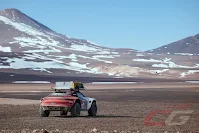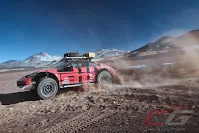For approaching 60 years, the Porsche 911 has been pushed to extremes on both the track and on the open road. Now, a fresh chapter is being written; a unique pair of experimental 911 sports cars are being tested where there are no roads, where the air is thin, where the temperature is far below freezing and even plant life can’t survive.
A team, led by endurance racer and adventurer Romain Dumas, has set out to explore the limits of the 911 and have opted for one of the toughest places on earth in which to begin the adventure – on the sheer slopes of Ojos del Salado, Chile, the highest volcano in the world.
The first test of the team and the cars has taken place. And, as a consequence, a Porsche 911 became one of very few vehicles of any kind to have ever reached such an extreme altitude.
Exploring up to 6,007 meters (19,708 feet), the 911, with Romain Dumas at the wheel, took on bolder strewn gradients as well as ice fields that tested the abilities of both the car and the team in temperatures hovering 30 degrees Celsius below freezing and with half the available oxygen in the air compared to at sea level. Impassable walls of seasonal snow and ice high up near the summit provided the upper limits of the test, which provided a tantalizing glimpse of what the cars are capable of in the right conditions. For now though, the test is complete – and the team elated by the experience.
At the core of each car is the 911 (Type 992) Carrera 4S equipped with a factory standard turbocharged flat-six engine developing 443 horsepower under standard conditions and the original seven-speed manual transmission. The 911 itself proved to be an excellent basis, through the mix of robust yet lightweight chassis construction, short wheelbase, ample power and the ability to cope well with extremely high altitudes. From this starting point, the engineers at Porsche’s research and development base in Weissach, near Stuttgart, working closely with Romain Dumas Motorsport, then let their combined creativity run wild as they worked to prepare it for the specific demands of the mountain.
The two cars were first equipped with roll cages, carbon fiber seats and harnesses to meet the safety requirements such a project demands. Next, portal axles were added to increase ground clearance (now 350 mm). New, lower gear ratios allow for precise, gentle throttle inputs at low speed and work well with large, newly fitted off-road tires. In addition, the cars are equipped with special lightweight, but extremely tough, Aramid fiber underbody protection to allow sliding over rocks.
A device called the Porsche Warp-Connecter was added. Originally designed for motorsport applications, it forms a mechanical link between all four wheels to allow constant wheel load even when the chassis is enduring extreme articulation – contributing to maximum traction. Manual, switchable differential locks were used along with an advanced steer-by-wire system. Finally, a winch was added at the front of the car along with revised bodywork to allow clearance for the 310 mm wide off-road wheels and tires. The cooling system also needed to move upward to allow the car to tackle more extreme off-road sections without fear of damage. As a finishing touch, the bodywork was finished in two distinctive liveries – one featuring the same Porsche Motorsport color scheme adorning the 963 LMDh racer and a second 911-themed livery designed by the styling team in Weissach.










No comments:
Post a Comment
Feel free to comment or share your views. Comments that are derogatory and/or spam will not be tolerated. We reserve the right to moderate and/or remove comments.